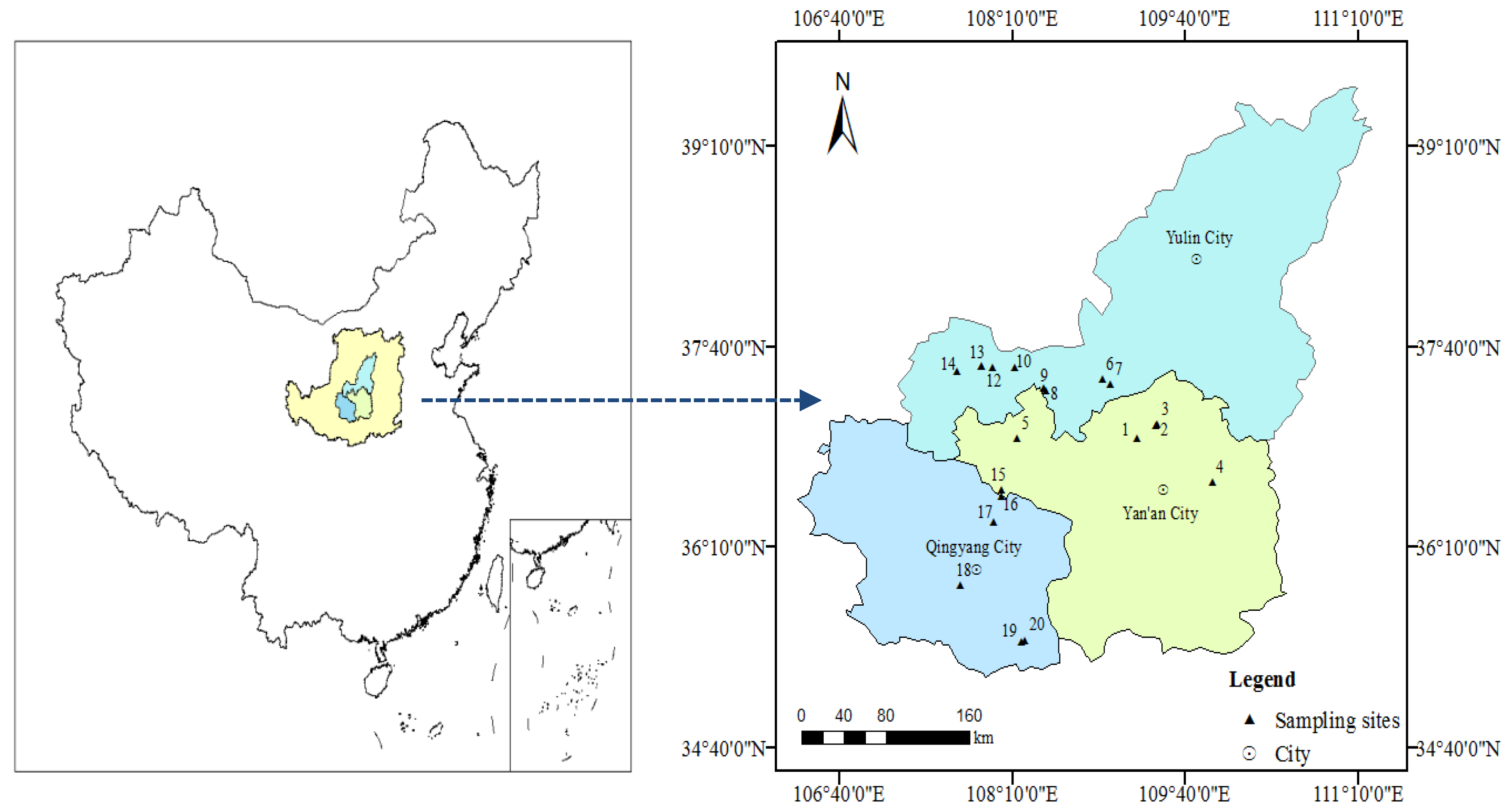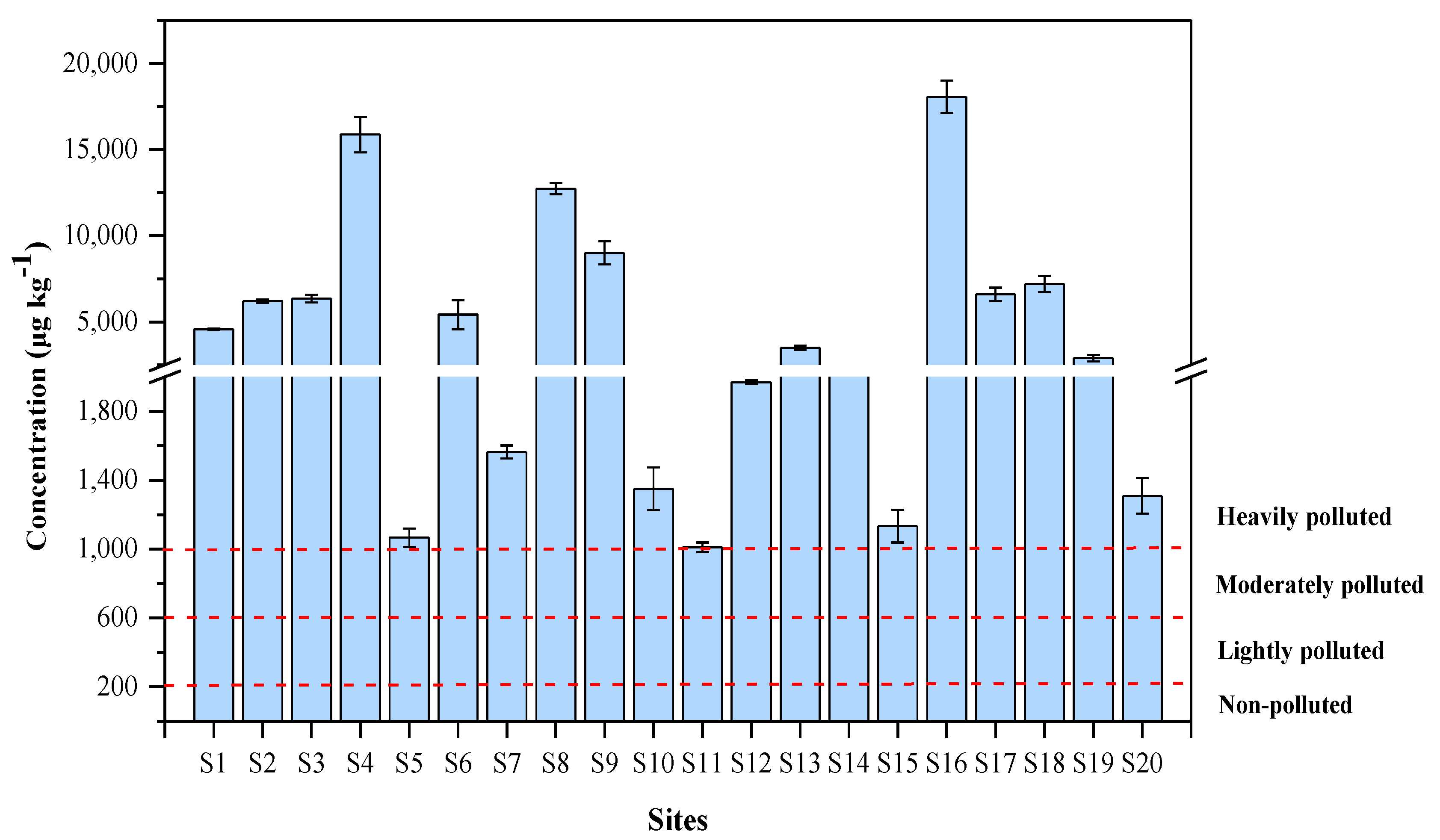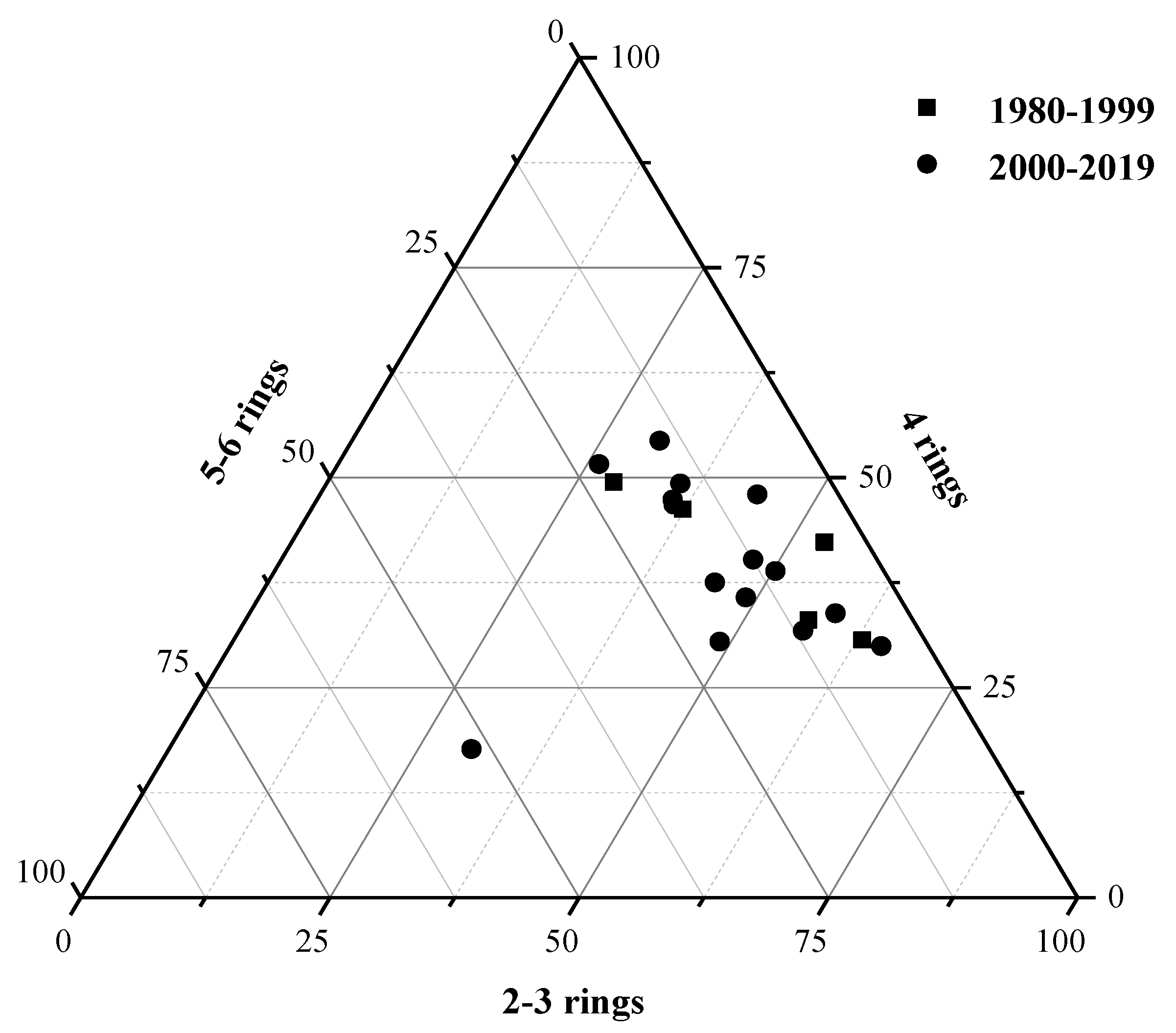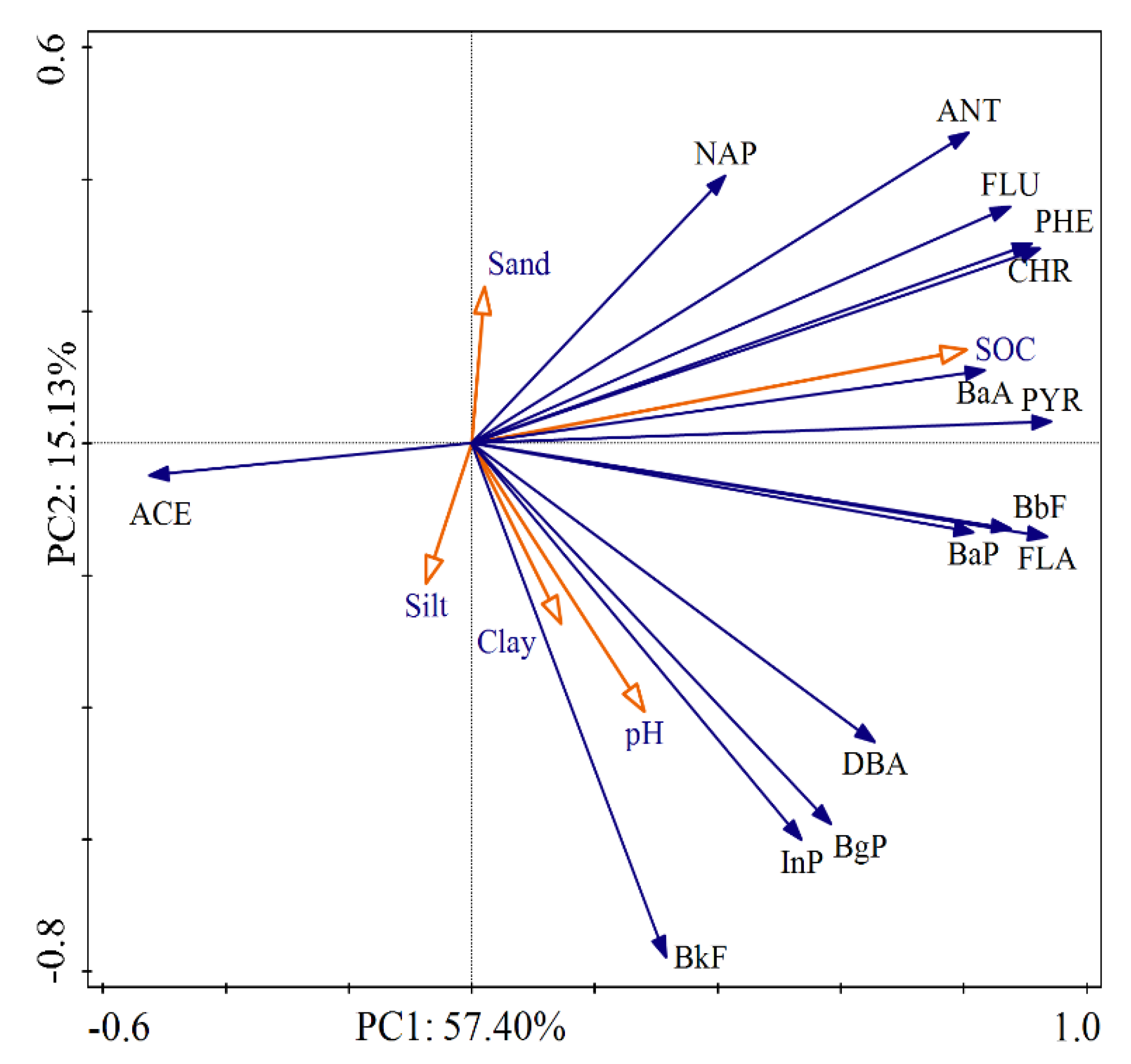Distribution, Origins and Hazardous Effects of Polycyclic Aromatic Hydrocarbons in Topsoil Surrounding Oil Fields: A Case Study on the Loess Plateau, China
Abstract
:1. Introduction
2. Materials and Methods
2.1. Soil Sampling and Preparation
2.2. Analysis of Soil Physicochemical Properties
2.3. PAHs Extraction and Analysis
2.3.1. Reagents
2.3.2. Extraction and Analysis of PAHs
2.3.3. Detection of PAHs
2.4. Data Analysis
2.4.1. Source Apportionment
2.4.2. Health Risk Assessment
2.4.3. Statistical Analysis
3. Results and Discussion
3.1. Concentrations and Compositions of PAHs
3.2. Relationships between PAHs and Environmental Factors
3.3. Source Analysis of PAHs
3.4. Assessment of Health Risk
4. Conclusions
Supplementary Materials
Author Contributions
Funding
Conflicts of Interest
References
- Nadal, M.; Schuhmacher, M.; Domingo, J.L. Levels of PAHs in soil and vegetation samples from Tarragona County, Spain. Environ. Pollut. 2004, 132, 1–11. [Google Scholar] [CrossRef] [PubMed]
- Kuang, S.P.; Wu, Z.C.; Zhao, L.S. Accumulation and risk assessment of polycyclic aromatic hydrocarbons (PAHs) in soils around oil sludge in Zhongyuan oil field, China. Environ. Earth Sci. 2011, 64, 1353–1362. [Google Scholar] [CrossRef]
- Yunker, M.B.; Macdonald, R.W.; Vingarzan, R.; Mitchell, R.H.; Goyette, D.; Sylvestre, S. PAHs in the Fraser River basin: A critical appraisal of PAH ratios as indicators of PAH source and composition. Org. Geochem. 2002, 33, 489–515. [Google Scholar] [CrossRef]
- Chen, H.Y.; Teng, Y.G.; Wang, J.S. Source apportionment of polycyclic aromatic hydrocarbons (PAHs) in surface sediments of the Rizhao coastal area (China) using diagnostic ratios and factor analysis with nonnegative constraints. Sci. Total Environ. 2012, 414, 293–300. [Google Scholar] [CrossRef] [PubMed]
- Ciarkowska, K.; Gambus, F.; Antonkiewicz, J.; Koliopoulos, T. Polycyclic aromatic hydrocarbon and heavy metal contents in the urban soils in southern Poland. Chemosphere 2019, 229, 214–226. [Google Scholar] [CrossRef] [PubMed]
- Wang, X.T.; Miao, Y.; Zhang, Y.; Li, Y.C.; Wu, M.H.; Yu, G. Polycyclic aromatic hydrocarbons (PAHs) in urban soils of the megacity Shanghai: Occurrence, source apportionment and potential human health risk. Sci. Total Environ. 2013, 447, 80–89. [Google Scholar] [CrossRef] [PubMed]
- Bolden, A.L.; Rochester, J.R.; Schultz, K.; Kwiatkowski, C.F. Polycyclic aromatic hydrocarbons and female reproductive health: A scoping review. Reprod. Toxicol. 2017, 73, 61–74. [Google Scholar] [CrossRef]
- Gao, P.; Xu, M.; Liu, Y.L.; da Silva, E.B.; Xiang, P.; Ma, L.N.Q. Emerging and legacy PAHs in urban soils of four small cities: Concentrations, distribution, and sources. Sci. Total Environ. 2019, 685, 463–470. [Google Scholar] [CrossRef]
- Cao, H.B.; Chao, S.H.; Qiao, L.; Jiang, Y.X.; Zeng, X.C.; Fan, X.T. Urbanization-related changes in soil PAHs and potential health risks of emission sources in a township in Southern Jiangsu, China. Sci. Total Envion. 2017, 575, 692–700. [Google Scholar] [CrossRef]
- Fu, X.W.; Li, T.Y.; Ji, L.; Wang, L.L.; Zheng, L.W.; Wang, J.N.; Zhang, Q. Occurrence, sources and health risk of polycyclic aromatic hydrocarbons in soils around oil wells in the border regions between oil fields and suburbs. Ecotoxicol. Environ. Saf. 2018, 157, 276–284. [Google Scholar] [CrossRef]
- Balgobin, A.; Singh, N.R. Source apportionment and seasonal cancer risk of polycyclic aromatic hydrocarbons of sediments in a multi-use coastal environment containing a Ramsar wetland, for a Caribbean island. Sci. Total Envion. 2019, 664, 474–486. [Google Scholar] [CrossRef] [PubMed]
- Wang, D.; Ma, J.; Li, H.; Zhang, X.C. Concentration and Potential Ecological Risk of PAHs in Different Layers of Soil in the Petroleum-Contaminated Areas of the Loess Plateau, China. Int. J. Environ. Res. Public Health 2018, 15, 1785. [Google Scholar] [CrossRef] [PubMed] [Green Version]
- Liu, P.; Liang, J.D.; Gao, W.; He, Y.L. Investigation of Soil Contamination Caused by Petroleum Exploitation in Yan’ an. J. Xi’an Jiaotong Univ. 2011, 45, 123–128. [Google Scholar]
- Norris, G.; Duvall, R.; Brown, S.; Bai, S. EPA Positive Matrix Factorization (PMF) 5.0 Fundamentals and User Guide. U.S.; Environmental Protection Agency: Washington, DC, USA, 2014.
- Yang, B.; Zhou, L.L.; Xue, N.D.; Li, F.S.; Li, Y.W.; Vogt, R.D.; Cong, X.; Yan, Y.Z.; Liu, B. Source apportionment of polycyclic aromatic hydrocarbons in soils of Huanghuai Plain, China: Comparison of three receptor models. Sci. Total Environ. 2013, 443, 31–39. [Google Scholar] [CrossRef]
- Ma, Y.K.; Liu, A.; Egodawatta, P.; McGree, J.; Goonetilleke, A. Quantitative assessment of human health risk posed by polycyclic aromatic hydrocarbons in urban road dust. Sci. Total Environ. 2017, 575, 895–904. [Google Scholar] [CrossRef]
- Han, J.; Liang, Y.S.; Zhao, B.; Wang, Y.; Xing, F.T.; Qin, L.B. Polycyclic aromatic hydrocarbon (PAHs) geographical distribution in China and their source, risk assessment analysis. Environ. Pollut. 2019, 251, 312–327. [Google Scholar] [CrossRef]
- Chen, Y.N.; Zhang, J.Q.; Zhang, F.; Liu, X.P.; Zhou, M. Contamination and health risk assessment of PAHs in farmland soils of the Yinma River Basin, China. Ecotoxicol. Environ. Saf. 2018, 156, 383–390. [Google Scholar] [CrossRef]
- Cao, W.; Yin, L.Q.; Zhang, D.; Wang, Y.Y.; Yuan, J.; Zhu, Y.; Dou, J.F. Contamination, Sources, and Health Risks Associated with Soil PAHs in Rebuilt Land from a Coking Plant, Beijing, China. Int. J. Environ. Res. Public Health. 2019, 16, 670. [Google Scholar] [CrossRef] [Green Version]
- Basavaiaha, N.; Mohiteb, R.D.; Singarec, P.U.; Reddyd, A.V.R.; Singhald, R.K.; Blahae, U. Vertical distribution, composition profiles, sources and toxicity assessment of PAH residues in the reclaimed mud flat sediments from the adjacent Thane Creek of Mumbai. Mar. Pollut. Bull. 2017, 118, 112–124. [Google Scholar] [CrossRef]
- Johnsen, A.R.; Wick, L.Y.; Harms, H. Principles of microbial PAH-degradation in soil. Environ. Pollut. 2005, 133, 71–84. [Google Scholar] [CrossRef]
- Maliszewska-Kordybach, B. Polycyclic aromatic hydrocarbons in agricultural soils in Poland: Preliminary proposals for criteria to evaluate the level of soil contamination. Appl. Geochem. 1996, 11, 121–127. [Google Scholar] [CrossRef]
- Liu, J.; Liu, Y.J.; Liu, Z.; Zhang, A.N.; Liu, Y. Source apportionment of soil PAHs and human health exposure risks quantification from sources: The Yulin National Energy and Chemical Industry Base, China as case study. Environ. Geochem. Health 2019, 41, 617–632. [Google Scholar] [CrossRef] [PubMed]
- Jenkins, B.M.; Jones, A.D.; Turn, S.Q.; Williams, R.B. Emission factors for polycyclic aromatic hydrocarbons from biomass burning. Environ. Sci. Technol. 1996, 30, 2462–2469. [Google Scholar] [CrossRef]
- Ouyang, Z.Z.; Gao, L.M.; Yang, C. Distribution, sources and influence factors of polycyclic aromatic hydrocarbon at different depths of the soil and sediments of two typical coal mining subsidence areas in Huainan, China. Ecotoxicol. Environ. Saf. 2018, 163, 255–265. [Google Scholar] [CrossRef]
- Nam, J.J.; Thomas, G.O.; Jaward, F.M.; Steinnes, E.; Gustafsson, O.; Jones, K.C. PAHs in background soils from Western Europe: Influence of atmospheric deposition and soil organic matter. Chemosphere 2008, 70, 1596–1602. [Google Scholar] [CrossRef]
- Liu, H.; Yu, X.L.; Liu, Z.R.; Sun, Y. Occurrence, characteristics and sources of polycyclic aromatic hydrocarbons in arable soils of Beijing, China. Ecotoxicol. Environ. Saf. 2018, 159, 120–126. [Google Scholar] [CrossRef]
- Deng, W.; Li, X.G.; Li, S.Y.; Ma, Y.Y.; Zhang, D.H. Source apportionment of polycyclic aromatic hydrocarbons in surface sediment of mud areas in the East China Sea using diagnostic ratios and factor analysis. Mar. Pollut. Bull. 2013, 70, 266–273. [Google Scholar] [CrossRef]
- Xu, J.L.; Wang, H.X.; Sheng, L.X.; Liu, X.J.; Zheng, X.X. Distribution characteristics and risk assessment of Polycyclic Aromatic Hydrocarbons in the Momoge Wetland, China. Int. J. Environ. Res. Public Health 2017, 14, 85. [Google Scholar] [CrossRef] [Green Version]
- Chen, M.; Huang, P.; Chen, L. Polycyclic aromatic hydrocarbons in soils from Urumqi, China: Distribution, source contributions, and potential health risks. Environ. Monit. Assess. 2013, 185, 5639–5651. [Google Scholar] [CrossRef]
- Simcik, M.F.; Eisenreich, S.J.; Lioy, P.J. Source apportionment and source/sink relationships of PAHs in the coastal atmosphere of Chicago and Lake Michigan. Atmos. Environ. 1999, 33, 5071–5079. [Google Scholar] [CrossRef]
- Olajire, A.A.; Altenburger, R.; Küster, E.; Brack, W. Chemical and ecotoxicological assessment of polycyclic aromatic hydrocarbon-contaminated sediments of the Niger Delta, Southern Nigeria. Sci. Total Environ. 2005, 340, 123–136. [Google Scholar] [CrossRef] [PubMed]
- Dong, T.T.T.; Lee, B.K. Characteristics, toxicity, and source apportionment of polycyclic aromatic hydrocarbons (PAHs) in road dust of Ulsan, Korea. Chemosphere 2009, 74, 1245–1253. [Google Scholar] [CrossRef] [PubMed]
- Khalili, N.R.; Scheff, P.A.; Holsen, T.M. PAH source fingerprints for coke ovens, diesel and gasoline engines, highway tunnels, and wood combustion emissions. Atmos. Environ. 1995, 29, 533–542. [Google Scholar] [CrossRef]
- Ou, D.N.; Liu, M.; Cheng, S.B.; Hou, L.J.; Xu, S.Y.; Wang, L.L. Identification of the sources of polycyclic aromatic hydrocarbons based on molecular and isotopic characterization from the Yangtze estuarine and nearby coastal areas. J. Geogr. Sci. 2010, 20, 283–294. [Google Scholar] [CrossRef]
- Jiang, Y.F.; Hu, X.F.; Yves, U.J.; Zhan, H.Y.; Wu, Y.Q. Status, source and health risk assessment of polycyclic aromatic hydrocarbons in street dust of an industrial city, NW China. Ecotoxicol. Environ. Saf. 2014, 106, 11–18. [Google Scholar] [CrossRef]
- Zheng, H.; Qu, C.K.; Zhang, J.Q.; Talpur, S.A.; Ding, Y.; Xing, X.L.; Qi, S.H. Polycyclic aromatic hydrocarbons (PAHs) in agricultural soils from Ningde, China: Levels, sources, and human health risk assessment. Environ. Geochem. Health 2019, 41, 907–919. [Google Scholar] [CrossRef]
- Deka, J.; Sarma, K.P.; Hoque, R.R. Source contributions of Polycyclic Aromatic Hydrocarbons in soils around oilfield in the Brahmaputra Valley. Ecotoxicol. Environ. Saf. 2016, 133, 281–289. [Google Scholar] [CrossRef]
- Hussain, K.; Hoque, R.R. Seasonal attributes of urban soil PAHs of the Brahmaputra Valley. Chemosphere 2015, 119, 794–802. [Google Scholar] [CrossRef]
- Liu, Y.G.; Gao, P.; Su, J.; da Silva, E.B.; de Oliveira, L.M.; Townsend, T.; Xiang, P.; Ma, L.Q. PAHs in urban soils of two Florida cities: Background concentrations, distribution, and sources. Chemosphere 2019, 214, 220–227. [Google Scholar] [CrossRef]
- Li, A.; Jang, J.K.; Scheff, P.A. Application of EPA CMB8.2 model for source apportionment of sediment PAHs in Lake Calumet, Chicago. Environ. Sci. Technol. 2003, 37, 2958–2965. [Google Scholar] [CrossRef]
- Jo, W.K.; Lee, H.H. In-vehicle levels of naphthalene and monocyclic aromatic compounds according to vehicle type. Environ. Eng. Res. 2009, 14, 180–185. [Google Scholar] [CrossRef]
- Larsen, R.K.; Baker, J.E. Source apportionment of polycyclic aromatic hydrocarbons in the urban atmosphere: A comparison of three methods. Environ. Sci. Technol. 2003, 37, 1873–1881. [Google Scholar] [CrossRef]
- Li, J.; Zhang, G.; Li, X.D.; Qi, S.H.; Liu, G.Q.; Peng, X.Z. Source seasonality of polycyclic aromatic hydrocarbons (PAHs) in a subtropical city, Guangzhou, South China. Sci. Total Environ. 2006, 355, 145–155. [Google Scholar] [CrossRef]
- Cao, Z.G.; Wang, M.M.; Chen, Q.Y.; Zhu, C.Y.; Jie, J.Y.; Li, X.X.; Dong, X.Y.; Miao, Z.; Shen, M.H.; Bu, Q.W. Spatial, seasonal and particle size dependent variations of PAH contamination in indoor dust and the corresponding human health risk. Sci. Total Envion. 2019, 653, 423–430. [Google Scholar] [CrossRef]





| Compounds | 1980–1999 | 2000–2019 | ||||
|---|---|---|---|---|---|---|
| Mean | Median | Range | Mean | Median | Range | |
| NAP | 125.06 | 105.08 | 64.46–196.55 | 106.54 | 93.35 | 66.13–173.61 |
| ACY | N.D. | N.D. | N.D. | N.D. | N.D. | N.D. |
| ACE | 92.76 | 67.08 | N.D.–157.98 | 117.35 | 129.18 | N.D.–148.78 |
| FLU | 447.80 | 160.88 | 78.05–1665.20 | 471.17 | 178.38 | 44.48–2383.70 |
| PHE | 1857.66 | 770.92 | 200.39–6836.28 | 2027.13 | 1709.03 | 127.81–8052.24 |
| ANT | 361.96 | 56.82 | N.D.–1317.29 | 247.27 | 123.33 | N.D.–1238.50 |
| FLA | 167.70 | 101.15 | 48.14–517.14 | 301.39 | 291.39 | 23.09–867.22 |
| PYR | 274.51 | 146.45 | 82.95–872.94 | 366.73 | 358.11 | 34.62–818.16 |
| BaA | 58.72 | 35.56 | N.D.–136.92 | 82.11 | 73.25 | 4.20–185.51 |
| CHR | 1287.65 | 493.29 | 296.07–3340.34 | 1357.79 | 1226.35 | 116.65–3796.53 |
| BbF | 189.04 | 150.16 | 48.07–449.25 | 244.37 | 185.32 | 27.08–572.11 |
| BkF | 18.04 | 18.55 | N.D.–21.09 | 35.50 | 28.15 | N.D.–67.05 |
| BaP | 100.91 | 82.55 | N.D.–214.56 | 96.00 | 73.11 | N.D.–225.40 |
| InP | 44.69 | 56.53 | N.D.–71.32 | 74.97 | 58.65 | N.D.–151.52 |
| DBA | 42.28 | 42.28 | N.D.–55.69 | 65.33 | 67.69 | N.D.–102.03 |
| BgP | 180.53 | 185.63 | N.D.–294.00 | 227.11 | 217.56 | 65.30–433.26 |
| ∑16PAHs | 5021.30 | 1968.79 | 1134.20–15,871.04 | 5662.82 | 5418.25 | 1010.67–18,068.80 |
| ∑7PAHs | 1658.93 | 753.88 | 370.96–4214.10 | 1877.19 | 1950.37 | 223.96–4642.40 |
| ∑LMWPAHs | 2775.74 | 1112.14 | 449.01–10,008.86 | 2890.40 | 2430.40 | 307.07–11,805.44 |
| ∑HMWPAHs | 2245.56 | 1114.75 | 527.78–5862.18 | 2772.41 | 2614.66 | 544.86–6263.36 |
| Exposure Pathway | 1980–1999 | 2000–2019 | ||||||||
|---|---|---|---|---|---|---|---|---|---|---|
| ILCRingestion | ILCRdermal | ILCRinhalation | ILCRs | ILCRingestion | ILCRdermal | ILCRinhalation | ILCRs | |||
| Child | Male | Min | 2.91 × 10−7 | 3.63 × 10−7 | 6.15 × 10−12 | 6.54 × 10−7 | 1.33 × 10−7 | 1.66 × 10−7 | 2.82 × 10−12 | 3.00 × 10−7 |
| Max | 1.74 × 10−6 | 2.17 × 10−6 | 3.67 × 10−11 | 3.91 × 10−6 | 2.15 × 10−6 | 2.68 × 10−6 | 4.55 × 10−11 | 4.83 × 10−6 | ||
| Mean | 8.54 × 10−7 | 1.06 × 10−6 | 1.81 × 10−11 | 1.92 × 10−6 | 9.91 × 10−7 | 1.24 × 10−6 | 2.09 × 10−11 | 2.23 × 10−6 | ||
| Female | Min | 2.99 × 10−7 | 3.73 × 10−7 | 6.33 × 10−12 | 6.72 × 10−7 | 1.37 × 10−7 | 1.71 × 10−7 | 2.90 × 10−12 | 3.08 × 10−7 | |
| Max | 1.79 × 10−6 | 2.23 × 10−6 | 3.78 × 10−11 | 4.02 × 10−6 | 2.21 × 10−6 | 2.76 × 10−6 | 4.67 × 10−11 | 4.97 × 10−6 | ||
| Mean | 8.78 × 10−7 | 1.09 × 10−6 | 1.86 × 10−11 | 1.97 × 10−6 | 1.02 × 10−6 | 1.27 × 10−6 | 2.15 × 10−11 | 2.29 × 10−6 | ||
| Adolescent | Male | Min | 1.74 × 10−7 | 4.33 × 10−7 | 1.19 × 10−11 | 6.06 × 10−7 | 7.95 × 10−8 | 1.98 × 10−7 | 5.46 × 10−12 | 2.78 × 10−7 |
| Max | 1.04 × 10−6 | 2.58 × 10−6 | 7.11 × 10−11 | 3.62 × 10−6 | 1.28 × 10−6 | 3.20 × 10−6 | 8.80 × 10−11 | 4.48 × 10−6 | ||
| Mean | 5.09 × 10−7 | 1.27 × 10−6 | 3.50 × 10−11 | 1.78 × 10−6 | 5.91 × 10−7 | 1.47 × 10−6 | 4.05 × 10−11 | 2.06 × 10−6 | ||
| Female | Min | 1.79 × 10−7 | 4.47 × 10−7 | 1.23 × 10−11 | 6.27 × 10−7 | 8.22 × 10−8 | 2.05 × 10−7 | 5.64 × 10−12 | 2.87 × 10−7 | |
| Max | 1.07 × 10−6 | 2.67 × 10−6 | 7.35 × 10−11 | 3.74 × 10−6 | 1.33 × 10−6 | 3.30 × 10−6 | 9.10 × 10−11 | 4.63 × 10−6 | ||
| Mean | 5.26 × 10−7 | 1.31 × 10−6 | 3.61 × 10−11 | 1.84 × 10−6 | 6.11 × 10−7 | 1.52 × 10−6 | 4.19 × 10−11 | 2.13 × 10−6 | ||
| Adult | Male | Min | 3.16 × 10−7 | 5.61 × 10−7 | 2.14 × 10−11 | 8.77 × 10−7 | 1.45 × 10−7 | 2.57 × 10−7 | 9.81 × 10−12 | 4.02 × 10−7 |
| Max | 1.89 × 10−6 | 3.35 × 10−6 | 1.28 × 10−10 | 5.24 × 10−6 | 2.33 × 10−6 | 4.14 × 10−6 | 1.58 × 10−10 | 6.48 × 10−6 | ||
| Mean | 9.26 × 10−7 | 1.65 × 10−6 | 6.29 × 10−11 | 2.57 × 10−6 | 1.07 × 10−6 | 1.91 × 10−6 | 7.29 × 10−11 | 2.98 × 10−6 | ||
| Female | Min | 3.43 × 10−7 | 6.10 × 10−7 | 2.33 × 10−11 | 9.53 × 10−7 | 1.57 × 10−7 | 2.79 × 10−7 | 1.07 × 10−11 | 4.37 × 10−7 | |
| Max | 2.05 × 10−6 | 3.64 × 10−6 | 1.39 × 10−10 | 5.69 × 10−6 | 2.54 × 10−6 | 4.50 × 10−6 | 1.72 × 10−10 | 7.04 × 10−6 | ||
| Mean | 1.01 × 10−6 | 1.79 × 10−6 | 6.84 × 10−11 | 2.80 × 10−6 | 1.17 × 10−6 | 2.08 × 10−6 | 7.93 × 10−11 | 3.24 × 10−6 | ||
© 2020 by the authors. Licensee MDPI, Basel, Switzerland. This article is an open access article distributed under the terms and conditions of the Creative Commons Attribution (CC BY) license (http://creativecommons.org/licenses/by/4.0/).
Share and Cite
Wang, D.; Zhu, S.; Wang, L.; Zhen, Q.; Han, F.; Zhang, X. Distribution, Origins and Hazardous Effects of Polycyclic Aromatic Hydrocarbons in Topsoil Surrounding Oil Fields: A Case Study on the Loess Plateau, China. Int. J. Environ. Res. Public Health 2020, 17, 1390. https://doi.org/10.3390/ijerph17041390
Wang D, Zhu S, Wang L, Zhen Q, Han F, Zhang X. Distribution, Origins and Hazardous Effects of Polycyclic Aromatic Hydrocarbons in Topsoil Surrounding Oil Fields: A Case Study on the Loess Plateau, China. International Journal of Environmental Research and Public Health. 2020; 17(4):1390. https://doi.org/10.3390/ijerph17041390
Chicago/Turabian StyleWang, Di, Shilei Zhu, Lijing Wang, Qing Zhen, Fengpeng Han, and Xingchang Zhang. 2020. "Distribution, Origins and Hazardous Effects of Polycyclic Aromatic Hydrocarbons in Topsoil Surrounding Oil Fields: A Case Study on the Loess Plateau, China" International Journal of Environmental Research and Public Health 17, no. 4: 1390. https://doi.org/10.3390/ijerph17041390
APA StyleWang, D., Zhu, S., Wang, L., Zhen, Q., Han, F., & Zhang, X. (2020). Distribution, Origins and Hazardous Effects of Polycyclic Aromatic Hydrocarbons in Topsoil Surrounding Oil Fields: A Case Study on the Loess Plateau, China. International Journal of Environmental Research and Public Health, 17(4), 1390. https://doi.org/10.3390/ijerph17041390





